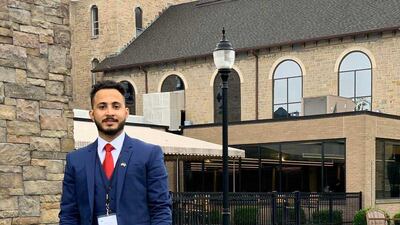For Omani native Mohammed Al Rawahi, the past month has been little short of a nightmare. As the coronavirus pandemic raced across the globe in March, the second-year business studies student at the University of Dayton in Ohio found his days filled with uncertainty.
When his university campus shut down on March 11, Mr Al Rawahi was faced with the choice of staying in the US or returning home. His father was concerned that travelling through airports – it would take three flights to get from Ohio to Oman – could put Al Rawahi at greater risk of contracting the virus than staying put.
“The embassy told us that if you want to come back to Oman you can, if you don’t, you can stay,” he says. His four housemates in Dayton, also students from Oman, decided to go home.
On March 22, Mr Al Rawahi followed suit.
“When I saw the number of cases of coronavirus was huge (in the US) I thought it was better to come back.” This week he finished a mandatory 14-day self-isolating quarantine in a room at his parents’ home in Samail, a 50-minute drive outside the Omani capital, Muscat.
Since departing the US, Covid-19 has exacted a terrible toll across the country, infecting more than half a million people or almost a third of the global affected total.
Like Mr Al Rawahi, tens of thousands of US-based college students from the Middle East have had their lives upended due to the coronavirus pandemic. More than three-quarters of all US colleges have asked their students to leave on-campus residencies, though some, such as Al Rawahi’s, have allowed international students to remain in place if they choose.
With dorm facilities shuttered at short notice last month, thousands faced the choice of either going home – highly troubling considering the unfolding shutdown in international travel – or fending for themselves.
In the academic year 2018-19, the latest for which figures are available, 81,126 students from Middle Eastern and North African countries were enrolled in third level education institutions in the US, according to data from the New York-headquartered Institute of International Education’s (IIE) 2019 Open Doors Report on International Educational Exchange.
The Middle Eastern student body makes up around eight per cent of all foreign students at university in the US, with students from China accounting for more than one-third of the total number. In the 2018-19 academic year, Saudi Arabia sent 37,080 students while the UAE, Egypt and Turkey sent 2,361, 3,675 and 10,159 respectively. On March 23, the UAE requested all of its foreign-based students to return home within 48 hours.
“The Covid-19 health crisis will affect international student mobility in this academic year and possibly for years to come,” concluded a report by the IIE in a survey of more than 230 higher level institutions in the US conducted in February. It continued that international higher education exchange is expected to see decreasing numbers of students travelling overseas and other long-term effects.
For those unable to return to their families in the Middle East or stay on campus, new challenges are emerging.
“The hardest part is keeping to a daily routine,” says Jaber Okayri, a criminologist major at Niagara University in upstate New York, who’s from Jizan in southwest Saudi Arabia.
“But since I am the president of the Saudi Student Association at the university, a lot of students get in touch looking for help.” Mr Okayri, who’s been staying with friends in Indiana since campus closed last month, has co-ordinated between students and the Saudi Arabian Cultural Mission in Washington DC to help the former find accommodation.
All the while, Mohammed Al Rawahi is still paying rent on his room in Dayton albeit with a $100 monthly discount, as the rental contract can’t be cancelled. He is also finding it difficult to continue his studies from home due to internet capability and time zone differences.
"I had an exam at 2am (Oman time) today and the internet isn't stable," he told The National.
Then there’s the long-term, headache-inducing challenges that lie ahead for Mr Al Rawahi and thousands of others. Students face difficulties in conducting enrolment interviews, accessing transcripts and making broader plans for the next academic year. Previously, course credits for online and in-person differ, but with all teaching now taking place remotely, the space for confusion is heightened.
In the short term, many students on scholarships fear their funding could be cut and despite campus life making up an important component of the college experience, most colleges are charging full tuition for this semester.
For many, long-standing plans for graduation ceremonies celebrated with family members flying in from the Middle East are cancelled and with on-campus classes and activities unlikely to resume again before August, the next six months will amount to little more than staring into a laptop screen.
Mr Al Rawahi has no idea when he thinks he’ll be able to come back to Ohio, and that’s the worst part, he said. “I miss the weather, going to campus, the restaurants,” he said, “and hanging out with my friends.

